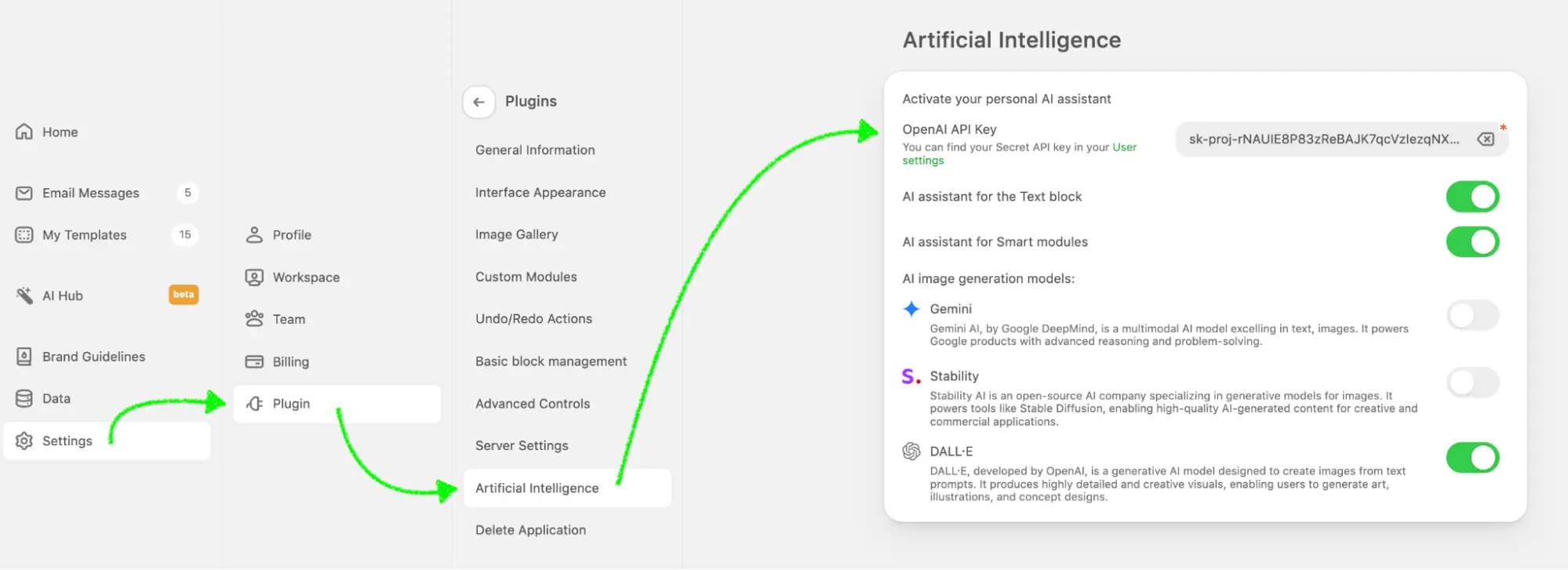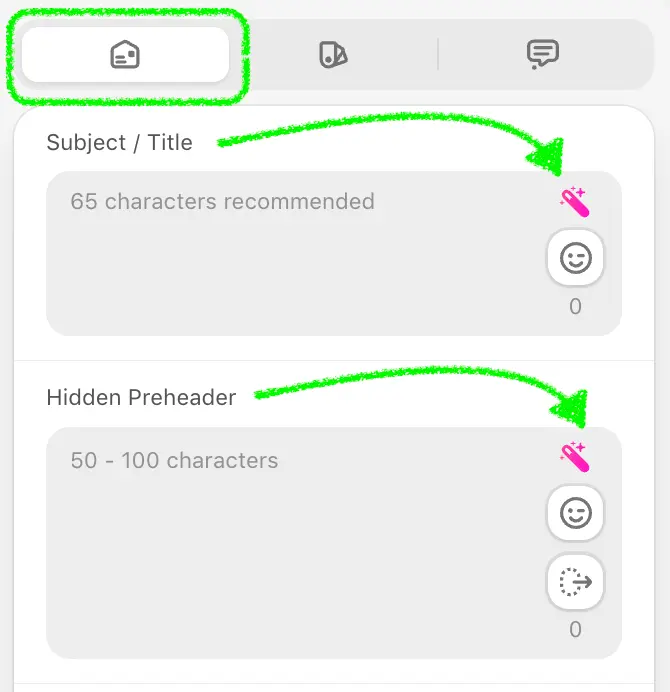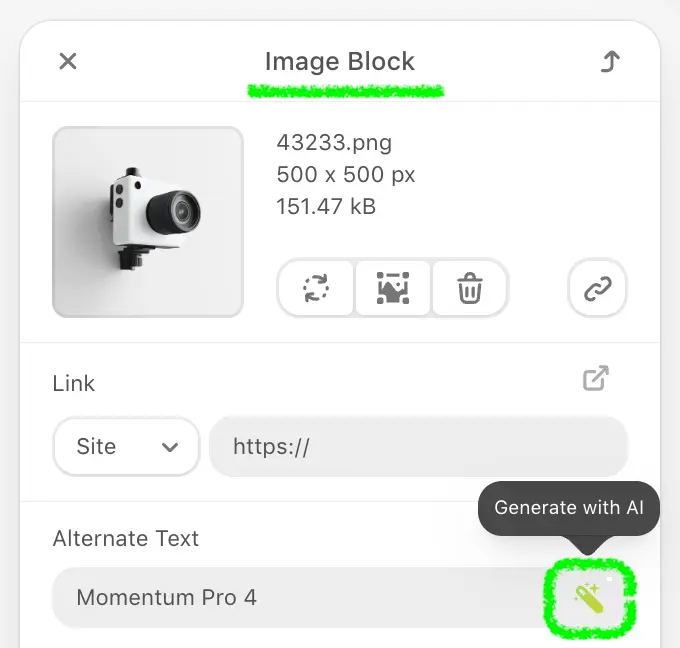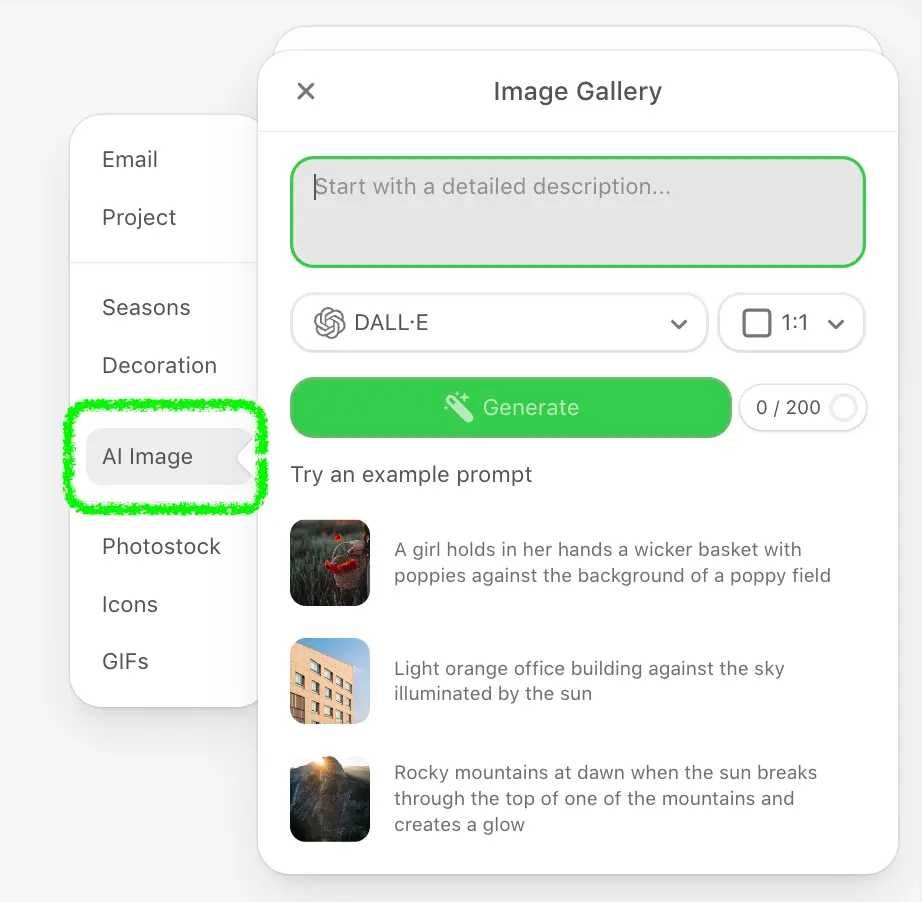Appearance
Artificial Intelligence
This section describes the AI capabilities available in the Stripo Plugin, which can be enabled via the Artificial Intelligence section of the plugin configuration page.
When activated, AI features enhance user productivity by assisting in content creation, image description, subject line optimization, and more. Plugin owners can selectively enable specific features and define the AI model used for image generation.

Some AI-powered tools require additional credentials to operate. In these cases, Stripo will prompt for the necessary API tokens or keys. These credentials are used solely to request data from the selected third-party services (OpenAI, Google Gemini, Stability AI) under the plugin owner's account. How to Get API Keys for AI Models?
Improve Subject Lines and Hidden Preheader
This utility helps marketers optimize subject lines and hidden preheaders using AI-generated suggestions. It enhances email engagement by offering smart phrasing options that improve open rates and attract user attention.
Where it appears

- When creating or editing an email, you'll find the magic wand icon next to the Subject Line and Hidden Preheader input fields.
- Click the icon to open a modal with suggestions generated by AI.
- You can scroll through multiple suggestions and apply the one you prefer by clicking Insert.
How suggestions are generated
- The AI analyzes the email’s content, including key topics, tone, and goal of the campaign.
- It leverages best practices from marketing communications to offer subject lines that:
- spark curiosity,
- highlight urgency or exclusivity,
- personalize the message,
- or offer clear value propositions.
- The generated suggestions aim to boost open rates while maintaining alignment with the email's tone and structure.
- Suggestions are concise (typically 40–60 characters for subject lines, 50–100 characters for preheaders) and avoid spam-triggering words or formatting.
- Users can regenerate suggestions if the first set doesn’t meet their expectations.
How to activate
- Go to Plugins → Artificial Intelligence.
- Enable the toggle for "Improve Subject Lines and Hidden Preheader".
- Insert your OpenAI API key.
Requirements
- OpenAI API Key
- Access to the
gpt-4omodel - Organization-level key (not personal)
AI Assistant for the Text Block
The AI Assistant for the Text block helps users quickly generate, rewrite, or improve written content inside emails. It is designed to save time and inspire more effective communication.
Where it appears

- When a user selects any Text block, a magic wand icon appears in the text toolbar above the content area.
- Clicking this icon opens a panel with access to the AI assistant features.
How it works
- The assistant offers several predefined actions (or "prompts"):
- Fix Grammar – Correct grammatical errors in the selected text.
- Make Shorter – Reduce the length of the selected content.
- Make Longer – Expand the content with more detail or structure.
- Translate – Translate the selected text into English.
- Change Tone of Voice – Adjust tone to be more formal, friendly, professional, etc.
- Explain as an Expert – Rephrase the content with more expertise.
- Add Emoji – Add suitable emoji to make the text more expressive.
- In addition to these quick actions, users can enter a custom prompt manually — for example: "Write this as a product announcement" or "Make it sound like a luxury brand".
- The assistant uses AI models to generate responses that align with marketing communication standards: clear, compelling, and relevant.
- Multiple suggestions may be offered, and users can insert or regenerate with a click.
- Inserted results can still be manually edited as needed.
How to activate
- Go to Plugins → Artificial Intelligence.
- Enable the toggle for "AI assistant for the Text block".
- Provide your OpenAI API key.
Requirements
- OpenAI API Key
- Access to the
gpt-4omodel - Organization-level key (not personal)
AI Assistant for Smart Modules
This tool is designed to help users improve the performance and clarity of structured content within Smart modules. It leverages AI to optimize headlines, descriptions, and text fields collectively.
Where it appears

- When a user selects an existing or newly created Smart Module and navigates to the Data tab in the settings sidebar, а magic wand icon appears above the list of content variables (e.g., Title, Description, Text).
- Clicking the icon triggers the assistant, which analyzes the overall content across all fields and suggests optimized versions for higher engagement.
How it works
- The assistant reviews the values of all editable Smart module fields (e.g., title, description, CTA text).
- It generates a cohesive and high-converting alternative, enhancing clarity, tone, and persuasiveness.
- The suggested changes are applied automatically.
- If the result is not satisfactory, the user can:
- Regenerate suggestions using the assistant icon again.
- Revert to the original version via the editor's version history controls.
- This ensures full flexibility while encouraging faster content iteration.
How to activate:
- Go to Plugins → Artificial Intelligence.
- Enable the toggle for "AI assistant for Smart modules".
- Provide your OpenAI API key.
Requirements:
- OpenAI API Key
- Access to the
gpt-4omodel - Organization-level key (not personal)
AI-generated Image Description
This tool helps users automatically generate alternative (alt) text for images, improving accessibility and email client rendering.
Where it appears

In the settings panel of the Image, Video, Banner, or Menu blocks, а magic wand icon appears next to the Alt text input field.
How it works
- When the user clicks the icon, the AI analyzes the content of the image.
- It then generates a short, relevant alt text description and automatically applies it to the input field.
- If the user clicks the icon again, a new variation will be generated.
- If the user is unsatisfied with the AI-generated result, they can always revert the change via the editor’s built-in version history.
How to activate
- Go to Plugins → Artificial Intelligence.
- Enable the toggle for "AI-generated Image Description".
- Provide your OpenAI API key.
Requirements
- OpenAI API Key
- Access to the
gpt-4omodel - Organization-level key (not personal)
AI Image Generation Models
This setting allows plugin owners to choose which AI model should be used to generate images from text prompts within the Stripo Plugin. AI-generated images can be used to enrich email designs, especially for visual storytelling, promotions, and banners.
Where it appears

- When a user opens the Image Gallery, a new tab appears labeled AI Image.
- Clicking this tab opens the AI image generation interface with the following elements:
- A text input field for entering a detailed image prompt.
- A model selector (e.g., DALL·E, Gemini, Stability).
- An aspect ratio selector (e.g., 1:1, 4:3, 16:9).
- A Generate button.
- A list of example prompts to help users understand how to write effective image descriptions.
How it works
- The user enters a text prompt describing the desired image.
- The selected AI model generates a corresponding image.
- The generated image replaces the example prompt area and is previewed in the interface.
- Users can:
- Regenerate the image by adjusting the prompt.
- Click to insert the image into the relevant email block.
- All generated images are saved in the plugin’s image gallery for future reuse.
Model selection and requirements:
- Plugin owners choose which AI image models are enabled in the Plugins → Artificial Intelligence section.
- Available models:
- Gemini – requires Project ID and API Key.
- Stability – requires Bearer Token.
- DALL·E (OpenAI) – uses the same OpenAI API key as text-related features.
How to activate
- Go to Plugins → Artificial Intelligence.
- Toggle on the desired image generation models.
- Enter required API credentials for each selected provider.
Requirements
- Valid API key/token for each selected model.
- For DALL·E, OpenAI API Key with
gpt-4oaccess (same key as for text) and access to image-generation models.
How to Get API Keys for AI Models
Below is a quick guide to generating and managing credentials for each supported AI provider.
OpenAI (GPT-4o and DALL·E)
To use OpenAI features for both text and image generation, you need an API key with access to:
gpt-4o(for text features)- DALL·E (for image generation)
Steps to generate the key:
- Go to OpenAI API Keys.
- Sign in and click "Create new secret key".
- Ensure your account is on a paid plan (minimum $5 credit top-up).
- Confirm the key has access to both
gpt-4oanddall-emodels.
Google Gemini
Gemini models require a project-specific API key.
Steps to generate the key:
- Visit Google AI Studio.
- Sign in with your Google account.
- Click "Get API key" and follow the guided steps.
Stability AI (Stable Diffusion)
Stability AI provides high-quality image generation via their Stable Diffusion models.
Steps to generate the token:
- Sign up or log in at Stability AI.
- Go to your account settings and navigate to API Keys.
- Click "Create API Key".
Once you’ve obtained the appropriate keys, paste them into the corresponding fields in Plugins → Artificial Intelligence to enable each service.
Using Your Own AI Assistant (via Extension)
If you want to replace Stripo’s built-in AI Assistant with your own solution, you can do so by implementing a custom Extension.
This allows you to:
- Fully override the default AI behavior;
- Launch your own UI (modal, panel, etc.) when the AI button is clicked;
- Connect any external AI model or service (e.g., OpenAI, Claude, internal LLM);
- Return generated text back to the editor for insertion.
How it works:
- The AI button will open your external dialog instead of the default Stripo modal.
- After user interaction, your extension must return the updated content via a callback.
- Stripo will then update the corresponding block or input field with the new content.
This integration is useful if you:
- Want to use your own AI infrastructure;
- Need to enforce specific tone of voice or content restrictions;
- Already use an AI assistant in other parts of your app and want to keep the experience consistent.
See the implementation example: